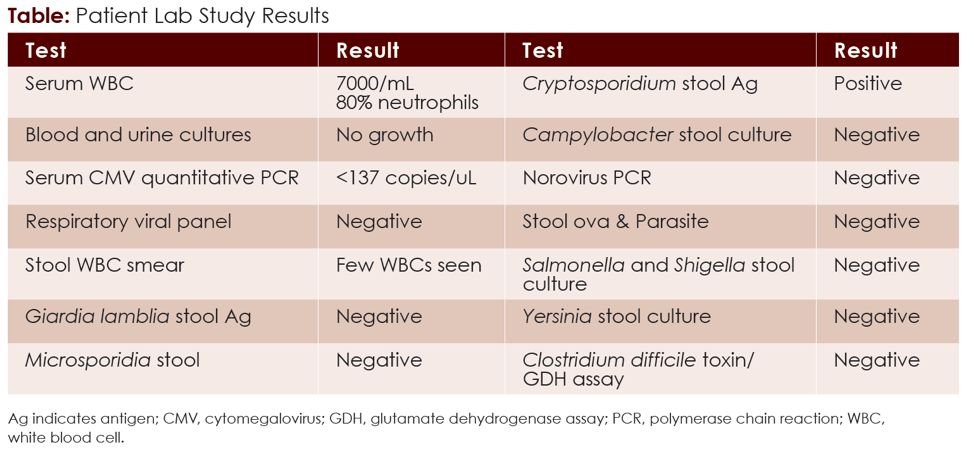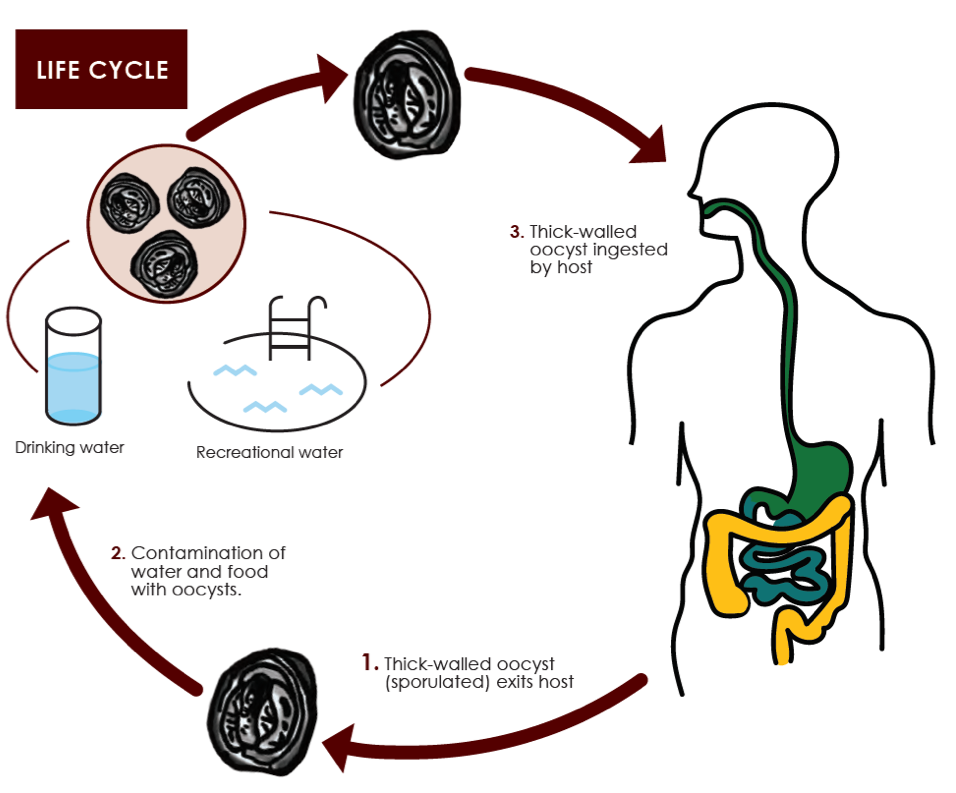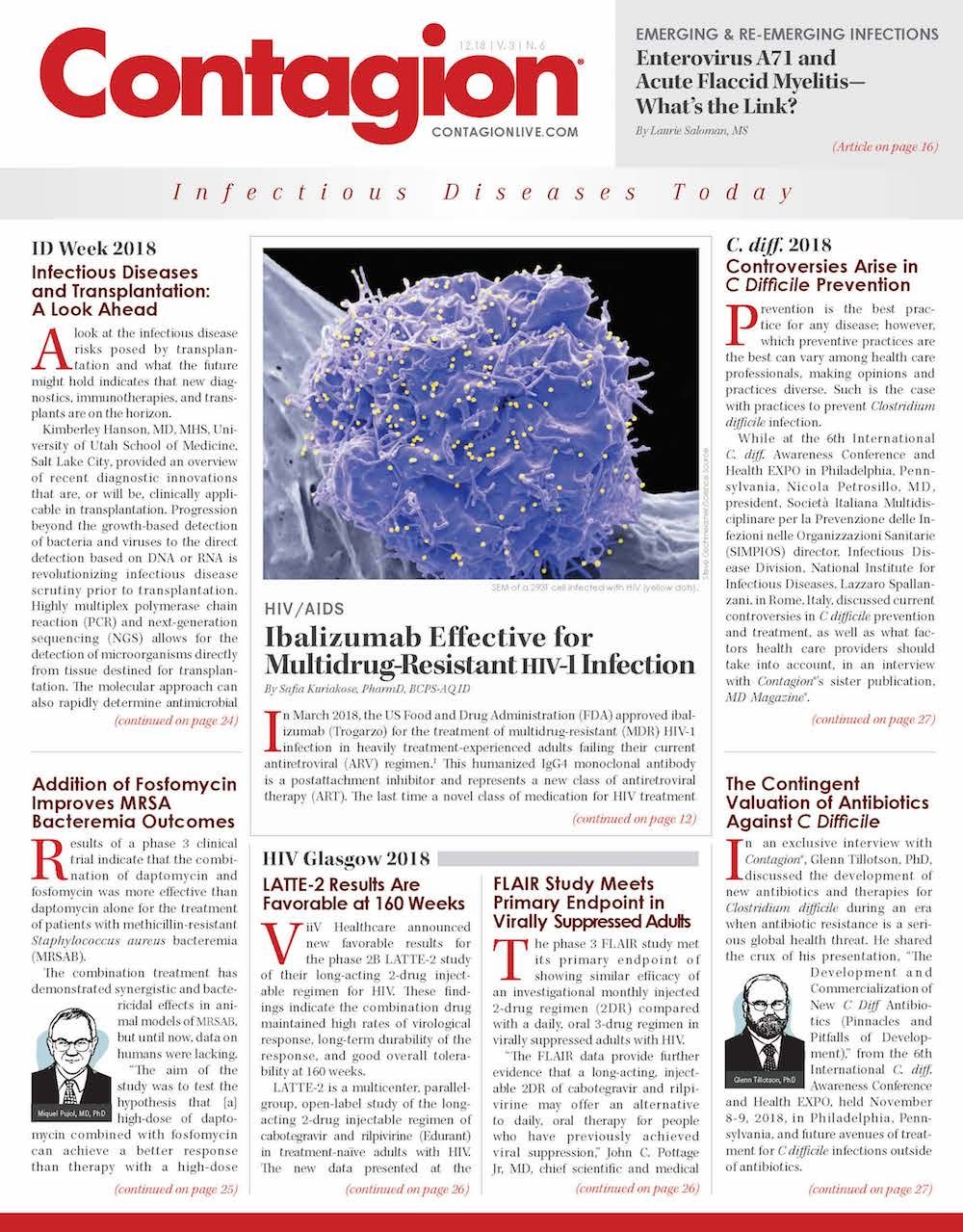Cryptosporidium: A Potentially Fatal Cause of Diarrhea in a Heart Transplant Recipient
Expanding the differential for diarrhea beyond Clostridium difficile.
HISTORY OF PRESENT ILLNESS
A 79-year-old man presented to a New Jersey hospital with a history of 5 days of profuse, watery diarrhea and lethargy. His symptoms started after he ate at a group holiday meal at his senior apartment complex home. He denied any fevers or chills, nausea, vomiting, shortness of breath, chest pain, and palpitations. He was in his usual state of health before the diarrhea and lethargy started. His baseline mental status was alert and oriented to person, place, and time, and he could function relatively independently. At the time of presentation to the emergency department, the patient provided limited history because of his lethargy.
PAST MEDICAL HISTORY
The patient had an orthotopic heart transplant in July 2000 secondary to ischemic cardiomyopathy. He was on tacrolimus and mycophenolate immunosup­pression and treated with methylprednisolone for rejection 9 months previously. He had a history of myocardial infarction at age 60, atrial flutter status post Medtronic pacemaker placement in 2009, chronic kidney disease stage 3A, hypertension, hyperlipid­emia, benign prostatic hyperplasia, and diverticulosis.
MEDICATIONS
Alendronate, calcium carbonate, carvedilol, myco-phenolate, dofetilide, finasteride, lisinopril, simvas­tatin, tacrolimus, rivaroxaban, ezetimibe.
ALLERGIES
Contrast dye, minoxidil.
EPIDEMIOLOGICAL HISTORY
The patient was born in the United States. He resides in an assisted-living facility in New Jersey where several contacts also reported diarrhea. He previ­ously worked as a forklift operator and worked in the military in Germany years ago. He denied any smoking, alcohol, and illicit drug use. He has no pets or animal exposure. He denied any recent travel, swimming, drinking of unpurified or well water, and recent illness and antimicrobial use.
PHYSICAL EXAMINATION
The patient appeared lethargic. His temperature was 91.6°F, and his blood pressure was 79/39 mm Hg. His heart rate was 80 beats per minute, and respira­tions were 22 breaths per minute. Lungs were clear to auscultation bilaterally. Cardiac exam showed normal S1 and S2 with no murmurs, rubs, or gallops. Abdominal exam revealed normal bowel sounds and no tenderness. No rash or edema was noted. He was alert and oriented to person, place, and time.
STUDIES
Labs showed a normal leukocyte count. His blood urea nitrogen was 145 mg/dL, creatinine level was 4.9 mg/dL (with a baseline creatinine level of 1.3-1.7 mg/dL), and an arterial blood gas showed a pH of 7.07, a pCO2 of 15 mm Hg, and a pO2 of 188 mm Hg. A chest x-ray did not show any consolidations or effusions. An echocardiogram showed an ejection fraction of 60% to 65%, mild left ventricular hypertrophy, an enlarged left and right atrium, and a normal right ventricle. There was mild mitral regurgitation, tricuspid regurgitation, and aortic regurgitation. Blood and urine cultures showed no initial growth. Work-up for causes of diarrhea was negative, including Clostridium difficile toxin/glutamate dehydrogenase assay, Salmonella, Shigella, Campylobacter, Giardia, Yersinia, ova, parasites, Norovirus, and cytomegalovirus. Respiratory viral panel and microsporidia were also negative (see TABLE).

CLINICAL COURSE
The patient was given 2.5 L of normal saline. He was started on intravenous (IV) vancomycin, cefepime, and levofloxacin and admitted to the intensive care unit (ICU). He was started on norepinephrine and vasopressin infusions, and was transferred to a cardiac ICU in Philadelphia, Pennsylvania, under the care of his transplant cardiologist. The transplant infectious disease team was consulted. Repeat blood and urine cultures were obtained. IV vancomycin and levofloxacin were discontinued, the patient was started on oral vancomycin and IV metroni­dazole, and cefepime was continued. His mycophenolate was also held. Pressor infusions were resumed.
DIAGNOSTIC PROCEDURES AND RESULTS
Stool testing was positive for Cryptosporidium antigen enzyme immunoassay using ImmunoCard (Meridian Biosciences; Cincinnati, Ohio). His final blood and urine cultures from both hospitals showed no growth after 5 days.
TREATMENT AND FOLLOW-UP
The patient was started on nitazoxanide, and his antibiotics were discontinued. The patient’s pressors were weaned off, and his vitals stabilized. He was transferred out of the cardiac ICU to the general medical floor. He demonstrated complete recovery within several days and was discharged with instructions to complete 2 weeks of nitazoxanide. A thorough local health department investigation did not reveal an identifiable source of his illness.
DISCUSSION
Cryptosporidium is a chlorine-resistant parasite found in water or soil contaminated with animal or human feces.1 C hominis and C parvum are the most common causes of human cryptosporid­iosis. Infection occurs by ingestion of Cryptosporidium oocysts, which are resistant to prolonged environmental exposure as well as many disinfecting agents. However, once the oocysts are ingested, the acidic environment of the gastrointestinal tract causes sporozoites within these oocysts to excyst. Infection of intestinal epithelial tissue occurs, leading to impairment of absorption and secretory functions. Infection may be caused by water and foodborne outbreaks, with the most significant occurring in 1993 in Milwaukee, Wisconsin, where inadequate sanitation at a water treatment facility resulted in an estimated 400,000 infections.
Immunocompetent hosts infected with Cryptosporidium may develop nausea, vomiting, abdominal pain, and watery diar­rhea. Infection in these patients is usually mild and self-limiting. However, immunocompromised patients may present with severe symptoms and significant metabolic derangements.2 Among the most vulnerable are patients with AIDS or solid organ transplant on tacrolimus-based immunosuppression. These patients have decreased T-cell function, which hinders cytokine release and subsequently a decreased immune response to control the infec­tion and eliminate the parasite from the body.3 A retrospective review of all solid organ transplant patients was conducted at 2 transplant centers from January 2001 to October 2010. Ten patients were found to be infected with Cryptosporidium. Infection in these patients was found to be self-limited, and their gastroin­testinal symptoms resolved without antiparasitic treatment.4
Diagnosis is made by stool enzyme immunoassay for Cryptosporidium antigens, as ova and parasite examination is of lower yield and requires acid-fast staining.5 Although most patients do not require treatment, patients with refractory symp­toms and those who develop signs of septic shock may require treatment, which involves reduction in immunosuppression in combination with antiparasitic therapy. The first line of treat­ment is nitazoxanide. In severely immunocompromised patients who do not respond, a combination of paromomycin and azithromycin may be used as well.6
LIFE CYCLE

Dr. Borja is a third-year internal medicine resident at Drexel University College of Medicine / Hahnemann University Hospital, both in Philadelphia, Pennsylvania.
Dr. Lee is a current internal medicine resident at Hahnemann University Hospital with an interest in infectious causes of diarrhea.
Dr. Benjamin Bluen is a faculty member of the Infectious Disease department of Cedars Sinai Medical Group. He completed his fellowship and residency training at Drexel University College of Medicine / Hahnemann University Hospital.
Dr. Hankins is an associate professor of medicine in the Division of Cardiology at Drexel University College of Medicine.
Dr. Lee is an associate professor of medicine at Drexel University College of Medicine. He has an interest in infections related to solid organ transplantation, particularly HIV transplants.
References
- Goldman L, Schafer AI. Cryptosporidiosis, In: Goldman-Cecil Medicine. 25th ed. Philadelphia, PA: Elsevier/Saunders;2016: 2133-2135.
- Yoder JS, Beach MJ. Cryptosporidium surveillance and risk factors in the United States. Exp Parasitol. 2010;124(1):31-39. doi: 10.1016/j.exppara.2009.09.020.
- Florescu DF, Sandkovsky U. Cryptosporidium infection in solid organ transplantation. World J Transplant. 2016;24;6(3):460-471. doi: 10.5500/wjt.v6.i3.460.
- Bonatti H, Barroso II LF, Sawyer RG, Kotton CN, Sifri, CD. Cryptosporidium enteritis in solid organ transplant recipients: multicenter retrospective evaluation of 10 cases reveals an association with elevated tacrolimus concentrations. Transpl Infect Dis. 2012;14(6):635-648. doi: 10.1111/j.1399-3062.2012.00719.x.
- Leitch GJ, He Q. Cryptosporidiosis-an overview. J Biomed Res. 2012;25(1):1-16. doi: 10.1016/S1674-8301(11)60001-8.
- Abubakar I, Aliyu SH, Arumugam C, Usman NK, Hunter PR. Treatment of cryptosporidiosis in immunocompromised individuals: systematic review and meta-analysis. Br J Clin Pharmacol. 2007;63(4):387-393. doi: 10.1111/j.1365-2125.2007.02873.x

